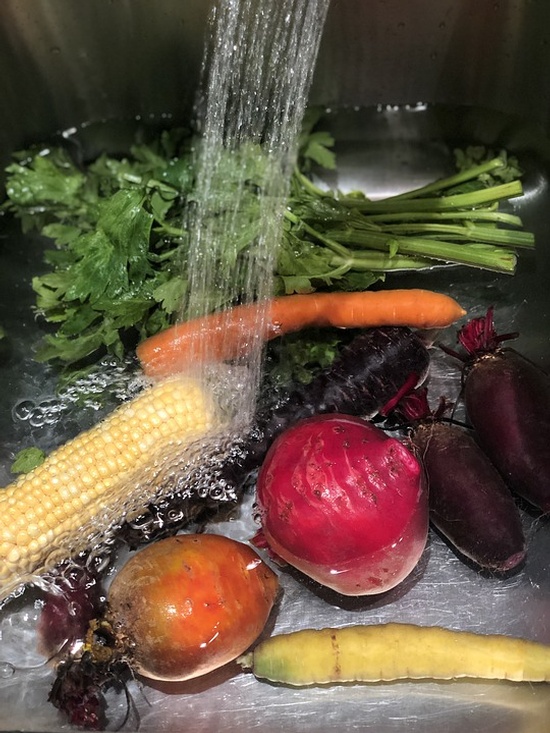20/4/2020
Wondering what vegetables to buy and how to wash them? especially during the Corona break?
Since the Corona outbreak, there are a lot of discussions on washing vegetables and sanitizing the grocery, etc. Some of this information is relevant, and some of it sounds like an epic ceremony. Let's understand the science, dispel fear, act, and be safe. Before we go further on cleaning it is important to know the journey your food undertakes before reaching your kitchen.
The journey of Vegetables and fruits - Before reaching our kitchen, at the farm, these are exposed to natural elements and soil microbes. In an industrial farm, these are also possibly exposed to pesticides, growth hormones, fertilizer residues, and toxins from the chemically killed insects, fungus, bacteria, etc. During long transit, these can be sprayed with preservatives. Before reaching the market, they may get a dash of chemical color, ripener, wax/polish, bleaches, and packing contamination.
During this time, longer the chain, more hands, surfaces, and transfers, your food passes through (irrespective of it being organic or non-organic) This is where the coronavirus many enter the chain, through an affected handler or surface.
You can now see (actually not) the kind of invisible things that are possibly sticking to our fruits and vegetables.
So what shall you do? Here are simple steps to save you a lot of trouble.
Buying -
- Choose organic/natural over chemically grown.
- Choose local, Ideally buy directly from the farmer, to reduce the transit steps.
- Eat seasonal and fresh, to eliminate the chances of consuming preserved, ripened, and polished.
- Avoid overly packed/wrapped fruits and vegetables. More surface=more chemical contamination, and more space for the virus to sit.
Handling- Especially after the COVID-19 outbreak, it is wise to stay conscious of the possible presence of the virus at the shop, on packing, and on the surface of vegetables. During the first handling, it is strongly advised to wear gloves and a mask (anything covering the nose and mouth). In order to prevent the virus to move from hands to mouth/nose. After entering the house, wash hands with soap properly.
Cleaning-
- for the coronavirus- make a simple mild soap bath. No special soap/detergent required. Simpler/natural the better. Dunk all your fresh purchases in it, leave for a minute, and gently but properly hand scrub these. (gloves not required). This will also clean the oil-based polishes.
- Rinse with clean water.
- Other Bacteria/microbes - Add baking/cooking/meetha soda (1 teaspoon/5 liter water) or wood ash (a teaspoon/5 liters) to water and soak the rinsed vegetables in this solution for 10 minutes. The alkalinity will neutralize the regular microbes and the soap residues on the surface. It also is known to remove/neutralize some pesticides.
- Rinse with clean water
Alternatively or optionally-
- Add a cup of vinegar to 4-5 liters of water and soak the vegetables in it for 10 minutes. This will wash away the common chemicals from the surface, and neutralize the bacteria as well.
- Rinse with water and lay to dry.
Storing - though it is a topic for one long extensive article, here are some basic tips.
- Drain excess water and Pat dry the vegetables. Shake off water from the leafy greens if you intend to store them for some time.
- As much as possible, separately store each of the vegetables in air tight containers in the fridge. Before closing the lid, you may leave them uncovered for an hour inside the fridge.
- onion, garlic, potatoes, semi ripe tomatoes, ginger, raw turmeric, etc can be safely stored outside in cool airy shaded containers.
Note -
- If you are growing and harvesting your own vegetables, organically, most of these steps are not required. if your produce is being handled by an outsider, you can do step 1-2.
- If you are buying directly from the farmer, e.g. from the farmers at GOFM or www.gofmonline.in, you know that the produce has the least miles and touches, you can just do step 1-2 and optionally Step 3-4.
- If your produce is organic but has traveled a long distance, steps 1-4 are highly recommended.
- If you are not sure of the growing method, Steps 1-6 will help reduce some of the surface contaminants.
- In the case of chemically grown produce, it is very difficult to remove all the chemicals from the surface and those which have entered inside the vegetable/fruit from the surface or roots.
- The above methodology does not claim to totally remove all of the microbes, toxins, and chemicals from the produce. Choosing food from the known clean source remains a safer bet.
To conclude, for everyday, I can't say it enough times the merits of growing your own food or getting it directly from an organic farmer. Know your farmer, be friends with your farmer, to maintain healthy and safe diet. Write use for information on washing or on maintaining a healthy life with local organic foods.
Author: Manas Arvind
About the Author - Manas Arvind has extensively worked in the space of sustainable agriculture and agri-ecology. He is a permacuture designer, helping create/convert farms into sustainable and value driven practices. He also joins in as a strategic advisor for startups and businesses in the sustainability, Eco-tech, and farming space.
